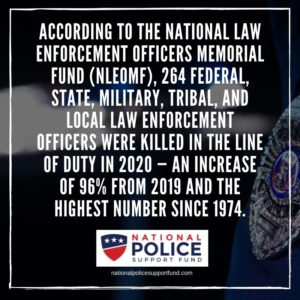More Than 250 Police Officers Made the Ultimate Sacrifice in 2020…
According to the National Law Enforcement Officers Memorial Fund (NLEOMF), 264 federal, state, military, tribal, and local law enforcement officers were killed in the line of duty in 2020 — an increase of 96% from 2019 and the highest number since 1974.
At least 145 of those deaths are attributed to COVID-19, which continues to wreak havoc on the law enforcement community. Even though life has gone back to normal for many Americans, the pandemic is still very much a reality for police officers who need to take extra measures to keep themselves safe while keeping our communities safe.

NLEOMF also reports that there were 48 firearms-related fatalities in 2020, making it the second-largest cause of death on the job for police officers. However, this number is down slightly from 51 fatalities in 2019. Those deaths came from investigating a suspicious person or activity, responding to domestic disturbance calls, attempting to make arrests, and responding to other calls and tactical situations.
While the number of firearms-related deaths has gone down, even one police officer lost is too many. We all need to do our part to make sure police have the support they need to remain safe on the job.
Texas and New York had the most fatalities, followed by Florida, Georgia, and Louisiana. Of the 264 officers killed, 246 were male and 18 were female. The average of officers killed was 47 and the average length of police service was 17 years.
As the COVID-19 pandemic continues, NLEOMF set up a task force to compile all COVID-19 deaths among law enforcement officers and make sure they are properly recognized at the organization’s memorial in Washington, D.C.
For more information about law enforcement fatalities in 2020, read the full report from NLEOMF.
Crime is on the rise across Illinois. As we continue to expand our advocacy in the state through the Police Issues Action Center of Illinois, we wanted to go one level deeper and look specifically at some of the most dangerous areas of the state. Using data from ADT Crime Statistics, here are some of the state’s most dangerous areas.








